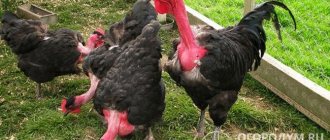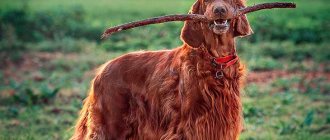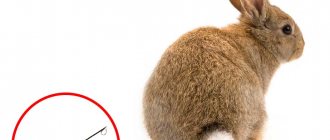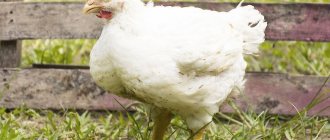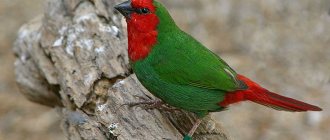When raising livestock at home, preference should be given to species common in a particular area. Firstly, such individuals are better prepared for the climatic and feeding conditions of the region. Secondly, to replenish the livestock, you can purchase sheep from nearby large livestock farms. And thirdly, the insemination process is greatly simplified, since you can still find a good stud ram at the same local breeding stations.
From the article you will learn where to start breeding sheep, how to select the right individuals for mating and raising young animals, and what features this area of animal husbandry has.
- Mating and recommendations for its implementation
Features of animal breeding
Sheep have highly developed herd instincts. This means that they always stay together and do not go far from the flock. Therefore, a small sheepfold or stall will be sufficient for breeding and maintenance. Even-toed ungulates are unpretentious to food and prefer to eat succulent green food.
The juiciest food is found in the pasture
In the warm season, it will be enough to introduce a small bait to make the diet more varied and nutritious. Sheep must be raised carefully because they are prone to diseases of the lungs and other organs of the respiratory system. Therefore, excessive air humidity and drafts are not allowed in the room. When grazing, it is worth keeping the flock away from wet places such as meadows and swamps, otherwise the artiodactyls can easily get sick.
Keeping and breeding sheep at home: a step-by-step guide
Since you decided to read this article, you are probably planning to start raising sheep as a business, or as a household subsidiary, to provide yourself and your family with fresh meat, in any case, you will have something to read.
You can also use the article navigation menu in the Article Contents block! Sheep farming is not one of the most profitable types of business. However, with a reasonable approach, you can provide your family with meat, milk and skins, and, if you wish, organize small production on the basis of your farm. Fur coats, sleeveless sheepskin vests and even hats, including astrakhan fur coats - with this alone, if you organize your business correctly, you can make money.
These animals, unpretentious to the conditions of keeping and feeding, produce quite significant volumes of meat, wool, milk, and some breeds and fat.
Breeds
The first stage of preparation for sheep farming is choosing a breed. Of course, you can buy mestizos, or even outbred ones, but this is very risky, since the owner will not be able to predict the characteristics of such animals, or determine the level of health or fertility. In addition, selling young animals in this case will be very difficult and difficult. First you need to decide on the required type of product that the animals provide.
Breed direction:
- Meat (Gorky, Texel, North Caucasian, Romney March);
- Meat – greasy (fat tail);
- Meat – wool (Gissar, Prekos, Latvian);
- Dairy (Karakul, Reshetilovskaya, Sokolskaya);
- Meat – milk-wool (Romanovskaya, Tushinskaya, Balabas, Karachevskaya).
According to the types of sheepskin, sheep are:
- Fine-fleece;
- Semi-fine-fleece;
- Semi-coarse-haired;
- Coarse-haired.
Which form of business to choose
Before purchasing livestock, (according to the law of the Russian Federation) it is necessary to register as a farm or peasant enterprise.
Organizing a legal entity is not necessary, but many prefer to form an LLC or obtain individual entrepreneur status.
This makes it possible to purchase a favorable loan, select an investor and save on taxes. In addition, many large buyers prefer to work with a legal entity, so timely registration will be useful in the long run. Livestock raised must obtain veterinary passports.
A peasant (farm) enterprise will require permanent registration in a specific selected area. Not all citizens like experiments with changing registration (like me); For this purpose, it is better, at the first stages of life and adaptation in the village, to choose the form of private subsidiary farming - personal subsidiary plot, which does not even need to be registered with the tax authorities. Accounting for private household plots is carried out by municipal (local) authorities (administrations of rural settlements) in the “household book”. It takes into account the address, the owner of the private plot, the size of the plot and the number of farm animals.
Content Types
Before buying animals, you need to decide on the place and method of keeping them based on the climate of the area and the financial capabilities of the owner. Sheep housing systems are:
- Pasture. Animals stay in grazing areas all year round and eat succulent green food. This method is well suited for areas with warm, dry climates.
- In the sheepfolds. Confinement of sheep is suitable for cold and wet regions with frequent rainfall. However, it is worth considering that they are active animals that need walks. Therefore, a good owner should take care of the walking area.
- Combined. Keeping sheep indoors in the winter, where they eat prepared food, and go to pasture in the summer. Well suited for temperate climates with pronounced seasons.
It is not recommended to immediately start a huge flock of several dozen animals. They are quite prolific, therefore, under conditions of proper maintenance, care and balanced nutrition, the livestock will increase by 2 or 3 times without additional costs per year.
To begin with, you can get 10-15 animals - this will be quite enough. You will be able to get acquainted with all the nuances and subtleties of sheep breeding, develop your own skills and techniques for breeding and care. The main criteria for selecting individuals are their level of health, heredity, rate of weight gain and fertility.
Perspective in sheep farming
Having made the right decision and purchased 3-4 sheep, in 2 years you will have a herd of 15-16 heads. Next is progression. I see one of the promising options for a sheep herd as follows. Today, without much difficulty, I cope with a small flock of 36 sheep.
If it were possible to naturally increase the herd to 200–300 heads and then distribute it among personal subsidiary farms (farms), such farming would bring collective income to residents of nearby villages, if, of course, they found the trouble to take up farming. And if there is no problem with increasing the number of sheep, then there are only a few people in modern villages who want to take on the labor of keeping sheep, using the example of the Vologda region.
The reasons, in my opinion, are simple and transparent: people have been discouraged from working for years (even for themselves, which is what actually attracts me to the farming field, this is the same entrepreneurship with a rural bias), running a farm, and earning money.
Today, an even stranger prospect is noticeable: every year in the countryside, even the number of plantings of potatoes and other vegetable crops is decreasing; because you can buy it in the store.
The trend is that soon summer residents, seasonally coming to the village for the summer and pensioners will plant more vegetable crops than indigenous villagers. This is the “stalemate” situation that occurs in some villages.
Diet
Depending on the type of animal keeping you choose, the approach to feeding sheep will vary. If they are kept on pasture all year round, it should have good grass cover and not be adjacent to wet places and swamps. In the event that there is not enough grass and plants for animals, additional feeding must be introduced - root crops or compound feed.
Compound feed is an excellent addition to the main diet
If you decide to keep lambs in a stall or sheepfold, then you need to stock up on feed in advance. The optimal diet may consist of silage (grass and corn), cereal hay, or legumes. It should be taken into account that at least 2.5–3 kg of silage must be allocated per day for 1 adult. The approximate ratio of hay, roughage and silage should be 2:5:4. In this case, the diet will be complete and balanced.
For weak, sick individuals, pregnant women and females during lactation, additional feeding with compound feed is needed. This also applies to breeding sheep at home. To ensure the necessary concentration of minerals in the body, you can put a few pieces of salt in the feeders.
Salt - lick is good for sheep
Additionally, you can feed with chalk and bone meal. For breeding wool breeds, it is recommended to focus on hay from cereals and legumes in the diet - the quality of the sheepskin will increase, and the fluff will be shiny.
Animals should not be allowed to drink standing water; they should only drink well and clean water 2 times in summer and 1 time in winter. Cold water is not allowed.
Hair cutting
Sheep shearing should be done mainly for two reasons: to sell the wool and to prevent the sheep from overheating in the summer with their own wool.
The most appropriate period for shearing needs to be determined as this can vary from sheep to sheep and an experienced sheep shearer should be considered as you may risk injuring the sheep by manually removing hair yourself.
- Before shearing, it is necessary to separate the sheep in the pen into categories. It is important to keep them hungry the day before to avoid bowel release during trimming and to keep the floor clean.
- Place the sheep on its back, making sure the belly is exposed. Make the sheep comfortable so they don't get scared. Start the haircut from the stomach, then go down to the groin, continue on the back and finish on the chest and neck.
- Apart from shearing, another area of care for your sheep is hoof care. Make sure the sheep has a dry walking surface and that there are no serious hoof infections. If necessary, remove excess growths, being careful not to go too deep so as not to reach sensitive areas.
Hoof leveling is applied depending on the climate. If it is dry, it should be done every six weeks, more often if it is wet. Another way to take better care of your sheep is to always deworm them and follow your veterinarian's orders.
Place of detention
The room where pets are kept must be clean, dry and easily ventilated. According to the rules of sheep breeding, there should be 2 square meters per individual. m. of free space. During the cold season, the stall does not need additional insulation (especially if wool sheep are bred). In the warm season, it should be cool, as in this case the wool grows better and faster. For this period, you can simply build a canopy protected from wind and draft.
Goat shed
When the time comes to turn the flock out to pasture, the transition to fresh feed should occur gradually. If you neglect this rule of sheep breeding, the entire herd can contract an intestinal infection and become seriously ill.
Grazing can begin when the height of grass, legumes and cereal crops reaches a minimum of 5 cm. During this time, the plants will have time to accumulate a sufficient amount of nutrients, vitamins and minerals.
After mowing, grazing becomes available after 25 days. Raising sheep at home requires that animals spend a minimum of 12 hours on sheep pasture. The daily consumption of grass and other plants is 10 kg per day per 1 adult.
Pastures and shelters
The area allocated for grazing is certainly one of the most important, as your sheep will benefit from being fed the freshest possible feed during the season and moving around to gain weight.
If you are planning to create a farm consisting of a small herd, you will need a designated area for grazing measuring about 100 x 100 meters. In addition, this area must be organized into intermediate areas to allow for rotation.
- The grazing barn is another important area for breeding sheep and should be constructed as a 5 x 5 meter enclosure with a canopy.
- To build a shelter, you can also use an old structure, equipping it properly and having a roof at least 1.5 meters high from the ground.
The system of feeders, which are placed inside the stall, should be equipped with a calculation of 40 cm per head, so that the sheep have enough space for quiet feeding without crowding.
Livestock breeding
For each breed of animal, puberty occurs at different times. On average it is from 4 to 9 months. However, you should not allow mating before the first year of life - at this time, the female’s body is not yet fully strengthened, and it will be difficult for her to give birth to offspring without compromising her own health.
Mating can be free and artificial. The artificial method requires less time and costs, so it is recommended for use with a large number of livestock on the farm. The annual turnover of the sheep herd is approximately 200-250%.
Pregnancy lasts approximately 4–5 months. At this time, the uterus needs increased nutrition. A month before the expected lambing date, you need to carefully trim the hair around the udder and tail. A week after lambing, young animals can be given feed concentrates for rapid weight gain.
A week after birth, lambs already begin to eat succulent feed
The average lifespan of sheep is 25 years. The age of a sheep or ram for breeding purposes should not exceed 7–8 years. Upon reaching 3 months, the first grading of sheep should take place - the distribution of individuals into value classes. The future structure of the herd is formed from individuals of one class of individuals.
Room
Before purchasing livestock, a novice farmer must set up a good sheepfold where his sheep will live. It is not enough to build a regular shed. The sheepfold must meet a number of requirements:
- Where adults will live, the air temperature should be +7 degrees, and in the section for keeping babies the thermometer should rise to +10 degrees.
- The sheepfold must have windows; they must make up 1/15 of the total space.
- Each animal must have its own personal space: for an adult this is 2.5-3 meters and at least 0.7 meters for a lamb.
- The floor must be hard and warm. It would be better if it was made of wood.
- The gate where the sheep will go out to pasture or for a walk should be quite wide so that the animals do not harm each other during a crush.
As in any living space, it is necessary to regularly do airing and general cleaning, take care of the ventilation system and be sure to designate a place where lambing will take place, as well as places where the sheep can be with the offspring so that no one disturbs them.
Care
Meat breeds can be prepared for slaughter starting from 4–9 months. It is worth considering that the older the animal, the tougher its meat. Slaughter occurs by cutting the cervical artery.
Sheep shearing with a clipper
Grooming of wool breeds occurs 1-2 times a year. Coarse wool sheep are shorn up to 3 times. It is recommended to cut animals in spring or autumn. If you are late or start this procedure too early, the fleece will significantly deteriorate its quality and will be unsuitable for use. A haircut that is cut too late may fail due to natural off-season shedding. Sheep with light skin are tagged by tattooing on the ear, and sheep with dark skin are tagged by plucking wool or rings.
Lambing
The ewe is also prepared for lambing. Such preparation includes:
- trimming hair on the back of the legs, around the anus and genitals;
- transferring the animal to a separate room or corner of the sheepfold;
- lining the room with a thick layer of straw.
The following signs indicate the imminent onset of labor in a lamb:
- construction of a nest by the queen;
- quite severe swelling of the vulva;
- changing the consistency of mucus to completely transparent;
- The udder enlarges and colostrum is released from it when pressed.
Attention! If these points are identified, the sheep in a separate pen are checked every hour. She can lamb while lying down or standing up. Immediately after the end of the process, they check whether all parts of the placenta have left the uterus. Then she is given warm water to drink and left with the babies.
Texel
Those who are considering breeding sheep for meat as a business should pay attention to this breed. Its representatives feel best in Central Russia. These are hardy and prolific animals.
Beginners will also like this breed for the reason that these rams, unlike other representatives of their species, do not have a rather unpleasant and specific odor. Therefore, breeding them is much more pleasant.
general information
If we talk about the profitability of raising sheep, as a business, such a project, as a rule, pays off very poorly, only 25%. This is explained by the fact that very large capital investments will be required at first. To raise livestock, it will be necessary not only to purchase the livestock itself, but also to organize normal living conditions for the animals.
If you consider raising sheep for meat as a business, then you need to be prepared for the fact that a lot of money will be spent on feed and personnel who will look after the livestock. In this regard, a profitability of 25% can be called a relatively normal indicator. However, it is not always worth referring to statistics. If you have experience in breeding such animals, then experienced sheep farmers and owners of livestock farms can boast of a fairly good and stable income.
If you survive the most difficult first stage, then in this case you can make excellent profits. It is worth noting that sheep are very unpretentious animals. They require minimal care, reproduce well and gain weight at a fairly high rate. Therefore, there will always be meat for sale.
How to attract more clients
To expand your customer base, it is recommended to visit agricultural fairs and send your offers to potential buyers who are ready for wholesale purchases. It would be a good idea to create your own website and indicate prices for products on it. If finances allow, you can order advertising on television or distribute advertising booklets on the street. Some organize school trips. Children love animals, and parents may become interested in fresh meat while visiting such areas. It is worth offering customers favorable discounts and promotions. This is especially true for those who are asking for meat not for the first time.
You can also talk about your activities in the newspaper, start a channel on YouTube and much more. The more people know about such a farm, the faster decent income will come.
Thus, we can say that such an idea for business is quite relevant. At the same time, we should not forget that the owner of such a farm, as well as his entire family, will always eat fresh meat completely free of charge. Therefore, the monthly profit is much higher. If you involve children and relatives in working on the farm, you can also reduce labor costs.
